As the core of committed people grew, it became easier to work toward common goals. Our next challenge was to find ways to provide employment for members so they could support themselves. This was especially difficult in Nevada County, where few opportunities were available as the general area had been in economic decline for some years. In order to have a steady income to pay the bills we instituted monthly dues of $35 for single people, or $50 for couples. It was clear that we needed to find a way to bring in income from outside the area so that people could pay the dues, create homes and live in the community.
In 1969 virtually the only source of income was the guest retreat. Kriyananda supported the community that first year through his service at the retreat (he was the “draw”), and directly that first winter by paying the mortgage. In 1970, others began to participate through dues and fees and membership payments.
Each person was responsible for his or her share. This was an important step, but equally so was the fact that people used initiative to find mechanisms for generating the means by which income could be earned by residents. Without this, people could not have lived at the Village unless they had private means, and few did. (If they were affluent enough not to work, they probably wouldn’t have been interested in living in such a primitive situation!) This building of
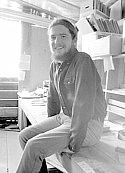
Keshava at incense and oils shop
businesses through individual energy was a foundation block for the community as it stressed attitudes of personal initiative and responsibility. An important point is that all the businesses were started by individuals, not by “ the community.” Many of these businesses were later taken over by the community but the original impetus was from one or two individuals. This was one of Ananda’s defining qualities.
After the tepee work project was completed in the fall of 1969, several went to San Francisco to find jobs for the winter. A small Ananda Ashram had been started by friends on Bush Street, and several Ananda members lived there while they worked in the city — Tom Sutliff, Binay, Sadhana Devi, and Mary Boone.Others, including Jyotish, Binay, and Haridas, started small cottage industries and brought them to Ananda in the spring.
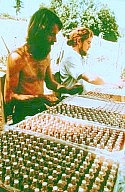 Jyotish spent the winter learning how to make incense, and created Ananda Village Products which later expanded to include essential oils and macrame plant hangers as well as the incense. Swami
Jyotish spent the winter learning how to make incense, and created Ananda Village Products which later expanded to include essential oils and macrame plant hangers as well as the incense. Swami
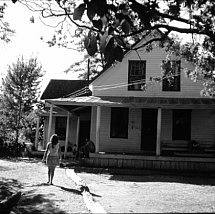
Original farmhouse, home of the first print shop
(Kriyananda) created a printing business in the original farm house, calling it Ananda Publications. A suitcase manufacturing business began in the barn, manufacturing foot lockers. Nakula made Kali Oats, a granola-type cereal; he also invented a machine to toast the oats. When I returned from San Francisco in the spring, I began sewing drawstring, comfortable pants and shirts for yoga and meditation, which I sold at our small boutique at the Meditation Retreat.
One ill fated summer project was the blackberry picking business. For a few weeks several people picked the wild blackberries growing on the property, and a visitor offered to deliver the blackberries to health food stores in Sacramento. We never saw him again, or the money from the blackberries. Perhaps he ate them all!
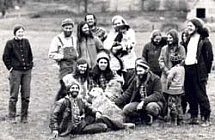
Incense and oils staff
By the end of 1970 we had nearly ten businesses. Some of them were begun by Swami, such as the Retreat and publishing business; the others were created by other members. As always, Swami encouraged creativity and superconscious thinking. Creating these businesses was an important activity that consumed much energy and attention in the early years
and throughout the rest of the decade. Some succeeded while
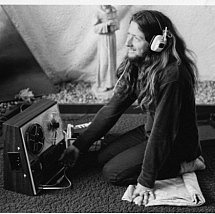
Vijay recording Swami
others were short lived, but the businesses were able to employ many of the people living at the Farm, and even to hire a few people from outside the community.
Ananda Products
Contributed by Haridas Blake
Early industries were always fun because Jyotish had the incense business, and Binay and I had started a jewelry making business. We were always having a friendly competition, and we tried to beat him in sales each month, but we never did. When we thought we were getting close,
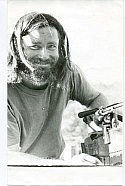
Binay – jewelry making
he added essential oils to the products, and we were finished! The essential oils sold like hot cakes. There was no way we were going to keep up in sales.
I didn’t understand why at first, but there was a lot of appreciation for our products. Finally I realized that it was the vibration that people were responding to. I finally got it when a new person came onto this spiritual path because he was introduced through our products.
The Ananda Candy Business
Contributed by Anandi Cornell
Everyone who came to Ananda had to find some way to create an income. At that time (1971) there were almost no health food candies on the market and when I arrived, my friend Fern (now Shivani) and two other women were starting such a business, using only healthy ingredients. The four of us
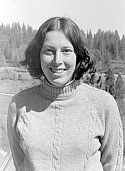
Anandi
developed four recipes: Aum bars (dried fruits, carob, coconut, and nuts); Deva Delights and Bhagavan Bars (made with peanut butter, honey, and milk powder); and Moksha Mints (made with walnut butter, milk powder, honey, and mint).
At first we made our candies in the Retreat kitchen, but we eagerly awaited a crafts building that was being built in the meadow below the Retreat. After the foundation, floor, and rafters of this building were completed, it was discovered that the building wasn’t really on our property and had to be scheduled for demolition!
We were, however, able to use the building for a year or so before the law caught up with us and we were required to dismantle it. The building was always cold since we rarely could get the wood stove working, so we wore our hikingboots and down jackets as we worked. Nakula, who had a granola business, took our candies around California and sold them. Mostly we each lived off of whatever savings we had. I remember being quite pleased at earning $90 one month, and that was more than usual.
After two years, we sold the business to another Ananda member, and all of us got other jobs.
Master’s Market
Contributed by Parvati (Cynthia) Hansen
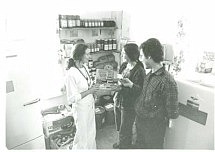
Parvati and Sanjay with customer
The idea of having a market at the Village evolved, as most things do, out of the very basic need to provide easily available food for a growing community of people. At the time I arrived at Ananda in the summer of 1972, the residents had few cars, meaning that any trip to town was a big occasion. Even so the community itself was bustling with energy and activity, with around 100 residents in total at that time.
The old farmhouse, which still stands in the center
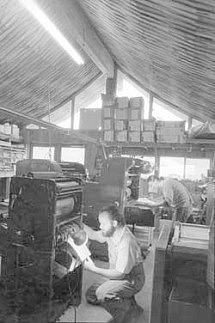
“new” print shop
of downtown Ananda today, had originally been used as a place for group meals. After this, it became the print shop, but by the fall of 1972 the print shop had moved up to the newly completed Publications building, leaving this area of the farmhouse vacant. There were a number of discussions about what it could be used for but no decisions were made at the time.
At the same time that this discussion was happening, another need was becoming very apparent. People, needing to buy food, began buying it from the Meditation Retreat kitchen. Asha, who was in charge of the kitchen at the time, did the best she could to accommodate them. But once the door was opened, the obvious need for food to be available in the community became overwhelming.
Swami kept saying to us in almost every satsang that we had with him, “If you see something that needs to be done here, then do it!” In other words, he was letting us know, right from the beginning, that we were the ones who were going to make this community a reality. He was also teaching us by his own dynamic example of energy and magnetism how to use the principles that Master had emphasized. I had the great opportunity to learn about both of these principles in a very dynamic way through developing Master’s Market.
To begin with, I had no money to start such a project. I don’t remember thinking of this as much of an obstacle at the time. I thought that at least I could manage to buy a couple of boxes of fruit each month to get things started. Although my own understanding was limited as to how all this would unfold, Divine Mother was there to help me each step of the way. Just a few months after I began this project, in the spring of 1973, a young man showed up at the Farm who was very interested in helping to make the market a reality. He had the amazing amount of $500 which he offered to put into the market funds.
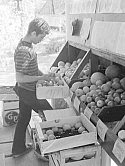
Sanjay at Master’s Market
This was a huge boon at the time and quickly catapulted the market out of the small room it had started in and into several downstairs rooms of the farmhouse. We bought a number of items and built shelves to put them on. Masters Market, the name which we gave it at that time, was beginning to supply a need for the residents of Ananda which they were becoming more aware of.
In the ensuing years the market grew rapidly and became not only a place to buy food but also a community center where people could see each other. Through the market, we did many things in those years to provide as much service to community members as possible. Among other things, the market had a deli with prepared foods for lunches, it became an outlet for the Ananda dairy; it showed movies on the lawn to raise money for an Ananda school movie projector; it brought crates of fruit up from the Sacramento valley for canning; and it provided a way for people to order foods in bulk. But mainly, the Market helped people to feel that the community itself was, little by little, becoming a reality.
Learning Experiences
Another idea for earning income took the form of work crews. One of these was planting trees for the US Forest Service, which was renewing tree plantations that had been logged.
Happy Camp
Contributed by Jaya Helin
The winter of 1971/72 was particularly cold and rainy. Toward the end of that winter, a few community members and Ed Abt, father of one of the Ananda High School students, came up with a seemingly brilliant idea for how we could make a sizeable income in a short period of time — why not plant trees for the U. S. Forest Service? Not only would we earn lots of money and do something good for the forest, we’d have great fun camping too! All we needed were some tools, a group of willing workers, and a contract. Since it was the winter season and economic opportunities were always in short supply, it didn’t take long for the idea to gain momentum. The group of planters soon coalesced, and tools were purchased. Mr. Abt, being older and more experienced in these sorts of things, obtained a contract without inspecting the site or having any personal experience. Soon, a group of us were on our way to planting trees in the mountains along the Humbolt River in northern California. Thus was the project Happy Camp (a name long remembered) set into motion. It was one of those early shared community experiences that later came to be known as learning experiences.
Happy Camp (its real name!) is a small logging community that was close to our contract location, but for us the towns name soon came to a source of great ironic mirth. Our vision of an idyllic forest experience was soon replaced by the harsh realities of commercial tree planting — muddy, clear-cut tracts clogged
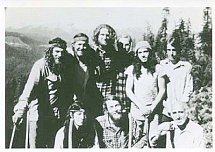
Happy Camp Crew
with debris, exhaustingly steep slopes, heavy loads, and long hours-all in a constant cold rain for which few us were adequately prepared. Rain — morning, noon and night! Our campsite was a landing by the side of a remote logging road, high above the town. There about fifteen of us, mostly men and a few women, living at close quarters, sharing meals and lodging for three weeks in a steamy school bus, a van, and a fourteen foot trailer.
Shivani managed most of the cooking, and meals were taken in the bus. Bathing was done by bucket or a dip in a nearby stream (Brrrrr!). Eventually a couple of enterprising fellows built a small sweat lodge from plastic and sticks, giving us a chance to warm up at least once each day. We worked from dawn to dusk until the job was done, our motivation being to simply get the contract done as soon as possible so we could go home. I can still remember the joy I felt that last day after the final tree was planted. Our joy was intense and our reward was a day of beautiful sunshine offering a panoramic view of forest and mountains in the distance, high above the river.
In the end, Happy Camp turned out to be a financial bust; we each made a pittance for our labor. But, in the long run, it was a wonderful opportunity for working together under conditions of great adversity. Although physically stretched to our core, we developed a bond with one another that is unique to groups who face a challenge. In the midst of everything, we meditated, chanted, sang, joked, and shared our adventure together as a community. Through humor and camaraderie, we turned what could have been bitter into shared sweetness and, indeed, an experience from which we learned a lot. In subsequent years, once we had navigated the ropes of contracting, skill, and proper equipment, planting in the winter and tree-thinning in the summer became an important source of income for community members.
For two and three weeks at a time, groups of young men would travel to remote locations in the mountains of California and Oregon, camping and working as a team. We approached everything cooperatively, sharing all risks, responsibilities, losses and rewards equally. Out of this came teamwork and habits of mutual trust, friendship and cooperation — all things upon which a community is built — that were used to build Ananda in subsequent years. Years later, one had only to say the words Happy Camp to another who had shared that adventure to receive in return a knowing smile.
Tree Planting
Contributed by Purushottama (Joseph) Selbie
In the late summer of 1975, Santosh (Brian O’Hara) rallied a large contingent of Ananda Members and apprentices to head up to Oregon for the winter to plant trees for the Forest Service. Swami was highly supportive because the work had the potential to create a huge profit which could be used to pay off the land, an oft repeated goal in those days. As a result it became a very large and ambitious project. Project victims — er, participants — included Jaya and Puru on the crew, Hridaya and Kirtani as cooks, and Sadhana Devi and Lakshmi looking after the kids.
An advance team went up to scout out a location and set up camp for over 30 people. Whitaker Creek Campground, in the coast range between Eugene and Florence, Oregon, became home for several months. A large army surplus tent was erected for a dining room, a smaller one for a kitchen, a medium sized one as a men’s dormitory and a Quonset-hut style tent for the temple. Everyone else arrived bringing tents, small trailers to live in, and, in one instance, what could have easily passed as a gypsy wagon. In a few short days camp routine was fairly well established.
Morning meditations in the Quonset temple (a large tent), breakfast in the dining tent, then the lunch and crew were loaded into various trucks and went off to plant trees before the sun even thought about rising. The crew would generally work from dawn to dusk (in winter that wasn’t very long) and return to camp in full darkness (days would go by for the crew without seeing the camp in sunlight) where, at last, a large, well-cooked, warm, nourishing and most welcome dinner would be waiting.
Spirits were generally high, although the work was very, very hard. A simple
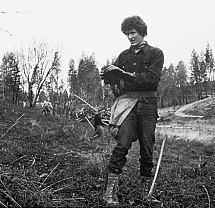
Puru planting trees
description of the work is that the crew planted small fir seedlings in areas that had been clear cut by logging companies. That might conjure up visions for you of people strolling through gently rolling hills occasionally putting a tree in a nicely dug hole and then lovingly patting the soil around the tree before moving on to the next spot.
The reality was much different. The clear cut areas were on very steep slopes. At times, it was possible to reach and touch the ground with your out stretched arm without bending down. People actually fell down slopes like skiers on a black diamond run. And the clear cut wasn’t clear by any means. Brush had grown up since the trees were cut, there were rock outcroppings, and worst of all was the slash. Slash was the term for all of the branches, shattered trunks and odd pieces of trees left over from the logging. A typical site looked like someone had been playing pick-up sticks on a steep slope with brush growing in and through the pick up sticks.
Meanwhile each crew member was wearing a big sack of trees slung across one hip and wielding a hoe-dad. The sack of trees could weigh 20 to 30 pounds, and felt like it weighed a hundred. The hoe-dad was very like a hoe, only the business end of the hoe-dad was longer. One swung the hoe-dad with as much strength as possible in order to penetrate the ground up to a foot, and then, using a levering motion, opened up a hole to put a fir seeding in. This was repeated by each member of the crew 750 to 1500 times in a day — while scrambling, squeezing, smashing, slipping, falling and climbing ones way through the slash. Just to make it perfectly difficult, it was almost always raining.
Spirits were not so high after the first few days!
Compounding the sheer difficulty of the work was the news that the project wasn’t going to make any profit after all; wages were going to be low, and the crew was committed, by contract to Uncle Sam, to planting 900,000 trees. It looked like it would be a lo-o-ong winter
But spirits revived. The work was hard but not impossible. Fresh air and hard work had a very healthy effect on everyone physically, and the shared experience of hardship created a wonderful camaraderie. One of the running jokes was that no one wanted to be the lead planter but preferred instead to be just another goon in the line. Being Californians, various crew members took it upon themselves to describe to the Forest Service overseers, amidst much laughter, what sunshine was actually like.
After a while, it felt rather like Whitaker Creek Campground was another Ananda community. Swamiji paid a visit, and gave Sunday Service and a talk. Reinforcements arrived periodically with news of back home. There were long meditations on weekends, weekly Sunday services, satsangs, and kirtans. Shyama and Gyandevi, Sadhana and Lakshmi’s little girls, were often seen wandering around the campground. And trips to nearby Eugene for dinner and a movie were a big treat.
A home burned down – well, a trailer anyway. Jaya and Sadhana’s little travel trailer caught fire on a sleepy Sunday afternoon. Luckily no one was hurt and Jaya, having returned from a long bike ride to find his home gone, remarked with a grin, “Easy come, easy go.”
In the end, after three or four months, no one made much money and the land certainly did not get paid off, but it was a remarkably important experience for many people. There was a good bit of attrition. You could almost hear some of crew who were relatively new to Ananda thinking, “I didn’t come to Ananda for this!” But for many it was a deepening experience; a very tangible experience of inner joy in the midst of hard work and outer difficulties.
The experience gained through planting trees had a practical outcome as well. Our newly-won skills were put to good use in reforesting the Ananda property after the fire of 1976.
The Garden
Haanel Cassidy had arrived in late 1969. After spending the winter away he returned in the spring and began cultivating gardens at the farm. Jaya, Sadhana Devi, Shivani, Devi and Anandi were among the first gardeners. Haanel often said that this was the first place had ever lived where you needed to
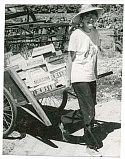
Savitri in the garden
drain the land first in order to irrigate it. The soil was heavy clay, with very little nutrients, and the terrain was hilly. Rainfall in the Sierras occurs between the months of October and April, then is nonexistent through the summer growing season. The property’s previous incarnation as a hog farm had done nothing to improve the soil, as no crops had been grown. Haanel had brought with him a small tractor and some irrigation equipment. We began tilling a very small
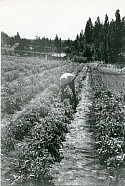
Gardens
plot of land near the farmhouse and adding whatever organic nutrients we could buy. At the same time, we started a compost pile, so by the end of the summer we had a little compost to add to the soil.
From Anandi: “While Haanel was a deep meditator and could have used this meditation time productively, he was also extraordinarily serviceful; he felt that a community should have a garden, and that he would take the responsibility for starting it. Then came what must have been quite a challenge for him. Haanel was a man of erudition, sophistication, and worldly success, as well as a person of deep spiritual refinement.
“The early days of Ananda have been lovingly referred to as the Age of Hair. It was the late 60s, and many of the new Ananda members were coming out of the hippie generation. There were some extraordinary souls who worked with him in the garden (and are Ananda leaders today), and there were also quite a few wild characters. One of his gardeners, Rishi, used to wear only a loincloth. Some of the other ex-hippie types were quite casual about material possessions, and most of Haanel’s tools vanished.
“I can still remember that, while we were dressed by choice in funky thrift store rags, Haanel would appear in neat chinos and a clean t-shirt, an outfit that on him looked dapper and refined. His posture was excellent, and he would share the secrets of gardening that he had acquired over his past 60 years. It was a priceless education in gardening, as well as in punctuality, responsibility, grammar, and just about anything else.
“As time went by, more people became interested in the garden and began helping with the work, so that eventually we expanded to about two acres, and there were as many as 50 volunteers working the gardens. The garden began providing food for the community and the Retreat guests through the summer months, and we even had a garden apprentice program for a few years.
“The garden was one of our best loved activities. Most of us, former city dwellers,
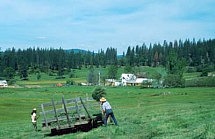
Haying
had had no opportunity for working in gardens. Years later, many of us remember fondly the time we spent there. Unfortunately, like farmers in many areas we were never able to make it work economically. Today, gardens flourish in back yards, and our community gardens have been given over to extensive landscaping, enjoyed by members and visitors.”
Other Income Sources
As early as 1969, Kriyananda instituted the Dollar a Month Club. Those who wished to participate would send a dollar a month and receive some of Yogananda’s unpublished sayings in return. It was a way for people to stay connected with Ananda, as well as to help the work financially.
Later we began a tithing program, in which the members offered a percentage of their income each month. Although everyone was welcome to participate, the focus was on those of us who were residents. By this time, many of us had been living extremely frugally for several years. In a prosperous country such as America, it is very easy for a person with a limited income to feel poor. This idea can be very seductive, and before we realized it some of us began to see ourselves as impoverished. Tithing is an excellent way of expanding ones awareness, and helps to break down the feeling of lack. Many people found that new economic opportunities turned up when they began tithing. As Kriyananda writes, “The very act of giving generates abundance. People who give selflessly to God find that He sustains them. Whatever energy they put out flows back to them, reinforced by the power that sustains the universe.”
Tithing
Contributed by Shivani Lucki
A long time ago, when Ananda had only one community and it was still very small and poor, the residents decided to embark together on a spiritual adventure, inspired by Yoganandaji’s teaching on magnetism. At the time the community had to pay the bank a monthly mortgage of $1500.00 for a ten-year period. Each resident in the community was receiving a monthly stipend of about $50.00, which was barely sufficient for the few basic necessities of life.
We decided to try the practice called tithing, and to give 10% of our stipend for this payment. There were about 50 of us, and so we raised only $250.00 each month. Although each person was giving only $5.00, it felt like a big personal sacrifice and of small overall concrete benefit. But, we had faith in Yogananda’s teaching, and we were enthusiastic to see the results.
Slowly, the magnetism began to work and many doors started opening. A contract to plant trees for the Forest Service was offered, and a group of us went off for a couple of months and planted pine trees. The money we earned went to pay the mortgage for those months.
New residents came to the community and some brought with them an economic activity. [Shivani’s husband] Arjuna was one of them, and he established a construction company, which
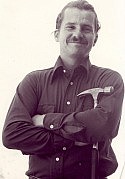
Arjuna
eventually employed about 15 people in the community. Each of these people was able to contribute more than $5.00 a month, and the construction company itself made donations from its earnings.
Other businesses were developed, and they began to contribute to the monthly payments and to provide jobs. The day finally arrived when the mortgage was paid, and the community could begin to grow in new directions. Thus was born Ananda’s motto: Many Hands Make a Miracle!
